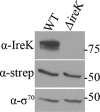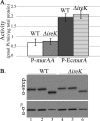MurAA is required for intrinsic cephalosporin resistance of Enterococcus faecalis
- PMID: 22290954
- PMCID: PMC3346666
- DOI: 10.1128/AAC.05984-11
MurAA is required for intrinsic cephalosporin resistance of Enterococcus faecalis
Abstract
Enterococcus faecalis is a low-GC Gram-positive bacterium that is intrinsically resistant to cephalosporins, antibiotics that target cell wall biosynthesis. To probe the mechanistic basis for intrinsic resistance, a library of transposon mutants was screened to identify E. faecalis strains that are highly susceptible to ceftriaxone, revealing a transposon mutant with a disruption in murAA. murAA is predicted to encode a UDP-N-acetylglucosamine 1-carboxyvinyl transferase that catalyzes the first committed step in peptidoglycan synthesis: phosphoenolpyruvate (PEP)-dependent conversion of UDP-N-acetylglucosamine to UDP-N-acetylglucosamine-enolpyruvate. In-frame deletion of murAA, but not its homolog in the E. faecalis genome (murAB), led to increased susceptibility of E. faecalis to cephalosporins. Furthermore, expression of murAA enhanced cephalosporin resistance in an E. faecalis mutant lacking IreK (formerly PrkC), a key kinase required for cephalosporin resistance. Further genetic analysis revealed that MurAA catalytic activity is necessary but not sufficient for this role. Collectively, our data indicate that MurAA and MurAB have distinct roles in E. faecalis physiology and suggest that MurAA possesses a unique property or activity that enables it to enhance intrinsic resistance of E. faecalis to cephalosporins.
Figures





References
-
- Aarestrup FM, Butaye P, Witte W. 2002. Nonhuman reservoirs of enterococci, p 55–99 In Gilmore MS, et al. (ed), The enterococci: pathogenesis, molecular biology, and antibiotic resistance. ASM Press, Washington, DC
-
- Barreteau H, et al. 2008. Cytoplasmic steps of peptidoglycan biosynthesis. FEMS Microbiol. Rev. 32:168–207 - PubMed
-
- Bernhardt TG, Wang IN, Struck DK, Young R. 2001. A protein antibiotic in the phage Qbeta virion: diversity in lysis targets. Science 292:2326–2329 - PubMed
-
- Blake KL, et al. 2009. The nature of Staphylococcus aureus MurA and MurZ and approaches for detection of peptidoglycan biosynthesis inhibitors. Mol. Microbiol. 72:335–343 - PubMed
Publication types
MeSH terms
Substances
Grants and funding
LinkOut - more resources
Full Text Sources
Other Literature Sources
Molecular Biology Databases
Miscellaneous

